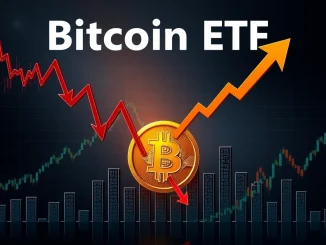
Get ready for a jolt! U.S. stock markets have opened in the red today, sending ripples of concern through the investment world. If you’re keeping an eye on your portfolio, you’ll want to understand what’s driving this early morning downturn. Let’s dive into the details of this concerning stock market decline and see what it means for investors.
Why is the Stock Market Experiencing a Decline Today?
The trading day began with a noticeable slump across all major U.S. indices. Here’s a snapshot of the key indicators at the opening bell:
- S&P 500: Down by a significant 1.30%
- NASDAQ: Experiencing a steeper drop of 2.19%
- Dow Jones Industrial Average: Lower by 0.70%
This synchronized dip across the board signals a broad market sentiment shift. But what’s behind this sudden market open weakness? While the exact reasons can be multifaceted and unfold throughout the day, initial reactions often stem from a combination of factors. These can include:
- Economic Data Releases: Any unexpected negative economic news released prior to or at market open can trigger immediate sell-offs.
- Geopolitical Events: Global uncertainties or escalating tensions can spook investors, leading them to reduce risk exposure in equities.
- Corporate Earnings Reports: Disappointing earnings or lowered guidance from major companies can weigh heavily on market sentiment, especially in sector-specific indices like the NASDAQ, which is tech-heavy.
- Interest Rate Concerns: Lingering worries about future interest rate hikes by the Federal Reserve can also pressure stock valuations, as higher rates make borrowing more expensive for companies and reduce the present value of future earnings.
Decoding the S&P 500’s 1.30% Drop
The S&P 500 index, often seen as a benchmark for the overall U.S. stock market, is down by 1.30%. This signifies a considerable decrease in the collective value of the 500 largest publicly traded companies in the United States. A decline of this magnitude at the market open can indicate:
- Widespread Selling Pressure: The breadth of the S&P 500 means that the selling isn’t concentrated in just a few sectors; it’s fairly widespread across the market.
- Investor Risk Aversion: A 1.30% drop in the S&P 500 could reflect investors moving away from riskier assets like stocks and potentially shifting towards safer havens such as bonds or cash.
- Potential for Further Decline: While it’s just the opening bell, a significant early drop in the S&P 500 can sometimes set the tone for continued downward pressure throughout the trading day.
NASDAQ’s Steep 2.19% Fall: Tech Sector Under Pressure?
The NASDAQ Composite, heavily weighted towards technology stocks, is experiencing an even sharper decline of 2.19%. This suggests that the technology sector, which has been a growth engine for the market in recent years, is facing particular headwinds today. Possible reasons for this pronounced NASDAQ downturn could be:
- Tech Sector Profit Concerns: High-growth tech companies are often more sensitive to interest rate changes. Concerns about future profitability in a potentially higher interest rate environment can lead to significant sell-offs in tech stocks.
- Valuation Adjustments: After a period of strong performance, some investors may be taking profits in the tech sector, leading to valuation adjustments and price corrections.
- Specific Tech Company News: Negative news or downgrades related to major tech companies within the NASDAQ can have an outsized impact on the index.
Dow Jones Industrial Average: Is the 0.70% Drop Significant?
The Dow Jones Industrial Average, comprised of 30 large, established U.S. companies, is down by a more moderate 0.70%. While less dramatic than the NASDAQ’s fall, a Dow Jones decline still carries weight. Consider these points about the Dow‘s performance:
- Broader Economic Concerns: Even though the Dow is less tech-focused than the NASDAQ, its decline suggests that broader economic worries are impacting even well-established, blue-chip companies.
- Impact on Investor Confidence: The Dow is often seen as a barometer of Main Street sentiment. A downturn here can reflect concerns about the overall health of the economy and corporate America.
- Relative Stability Compared to NASDAQ: The smaller percentage drop compared to the NASDAQ might indicate that while there’s concern, it’s potentially less acute in the more traditional sectors represented in the Dow.
Navigating the Market Downturn: What Should Investors Do?
Seeing red across your portfolio can be unsettling, but it’s crucial to maintain a calm and informed approach. Here are some actionable insights for investors during a stock market decline:
- Don’t Panic Sell: Emotional reactions can lead to poor decisions. Avoid impulsive selling based on short-term market fluctuations.
- Review Your Portfolio: Assess your asset allocation and risk tolerance. Is your portfolio aligned with your long-term financial goals?
- Stay Informed: Keep up-to-date with market news and analysis from reputable sources to understand the drivers behind the downturn.
- Consider Dollar-Cost Averaging: If you have a long-term investment horizon, market dips can present opportunities to buy quality stocks at lower prices through dollar-cost averaging.
- Seek Professional Advice: If you’re unsure about how to navigate market volatility, consult with a financial advisor who can provide personalized guidance.
Conclusion: Staying Resilient in a Volatile Market
Today’s opening bell has certainly rung with a note of caution for U.S. stock markets. The decline in the S&P 500, NASDAQ, and Dow Jones serves as a reminder of the inherent volatility of financial markets. However, it’s important to remember that market corrections are a normal part of the investment cycle. By staying informed, maintaining a long-term perspective, and avoiding emotional reactions, investors can navigate these periods of uncertainty and position themselves for future growth. Keep a close watch on market developments throughout the day, and remember that informed decisions are the best defense in any market climate.



